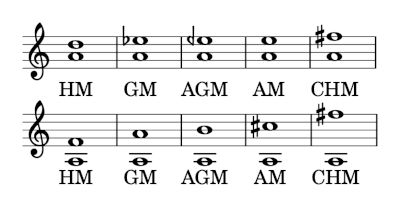More ways of splitting the octave
in an earlier post I said that the arithmetic mean of two frequencies an octave apart is an interval of a perfect fifth, and the geometric mean gives a tritone. This post will look at a few other means.

The harmonic mean (HM) gives a perfect fourth.
The arithmetic-geometric mean (AGM) gives a pitch about midway between a tritone and a fifth, a tritone plus 50 cents.
The arithmetic mean gives a perfect fifth.
The contraharmonic mean gives an interval of a major sixth.
The intervals for HM, AM, and CHM are exact, using just tuning. The intervals for GM is exact using equal temperament. The AGM is not close to a chromatic tone in any system.
If we take the means of A 440 and A 880, the AGM is an E half-flat (hence the backward flat sign above).
EquationsHere are the equations for the various means:
The AGM is defined iteratively: Take the GM and AM of the pair of numbers, then take the GM and AM of the result, and so on, taking the limit. More detail here.
FrequenciesHere are the frequencies of the means.
|------+-----| | Mean | Hz | |------+-----| | HM | 586 | | GM | 622 | | AGM | 641 | | AM | 660 | | CHM | 733 | |------+-----|Lilypond
Here's the Lilypond code that was used to create the music notaton above.
\begin{lilypond}\new Staff \with { \omit TimeSignature} { \relative c''{ <a d>1 <a ees'>1 <a eeh'>1 <a e'>1 <a fis'>1 | } \addlyrics{"HM" "GM" "AGM" "AM" "CHM" }}\end{lilypond}Update: Two octavesWhat if we look at frequencies two octaves apart, 220 Hz and 880 Hz? You might expect the size of the intervals to double. That intuition is exactly correct for the geometric mean: a tritone is half an octave (on a log scale) and so two tritones is an octave.
This intuition is also approximately correct for the arithmetic-geometric mean. But it over-estimates the harmonic mean and under-estimates the arithmetic and contraharmonic means.
